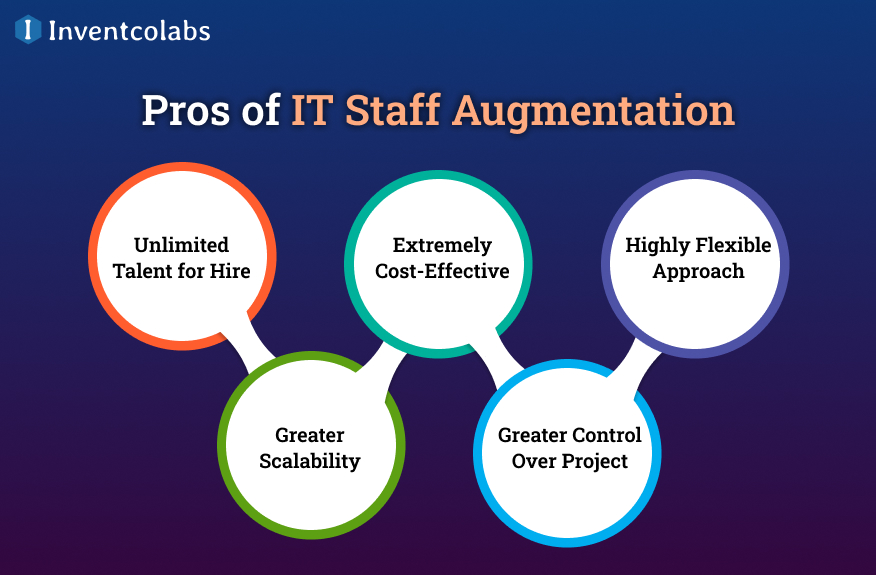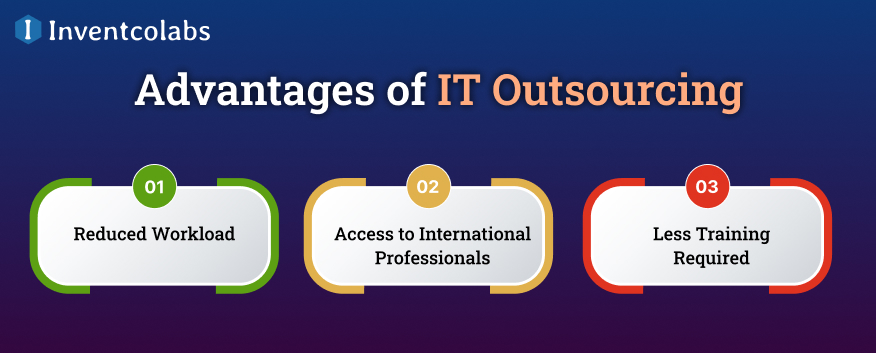Staff augmentation can temporarily add external talents to your team, offering flexibility and specialist capabilities. Outsourcing is handing complete tasks or processes to third-party companies to reduce costs and increase efficiency. The choice between them is based on your specific project needs and business objectives, which can spark curiosity about the best choice for your business.
There are many benefits to outsourcing, such as time and cost reduction, improving operational efficiency and competitive advantage, and allowing you to concentrate on your company’s core business; companies are more likely to outsource their IT tasks to a third party. Outsourcing IT-related projects or positions to experts is much easier than setting up an in-house team. This is why outsourcing software development for businesses, particularly start-ups, is becoming increasingly popular in recent years.
There are a variety of cooperating models you can choose from software providers, including staff augmentation and outsourcing IT, which are regarded as the two most effective options. Both concepts are confusing to people when they first encounter outsourcing. This article will comprehensively examine the differences between staff enhancement and project outsourcing to help you comprehend.
What is IT Staff Augmentation?
The staff augmentation model provides an IT outsourcing model that allows customers to recruit additional software developers, referred to as contractors, to perform specific roles or tasks within their development team for projects. In most cases, these employees are only employed for short-term engagements based on the duration of the project and the project’s requirements for the client.
Through IT staff augmentation, companies can quickly and efficiently acquire the knowledge and expertise they require without the burden that comes with a commitment to a longer-lasting term and the lengthy process of hiring and screening permanent employees. This can be accomplished by having the new staff and the internal team in the customer’s offices or remotely from their home or workplace.
By utilizing staff augmentation services, companies can make informed decisions on which qualifications are necessary to ensure the success of their whole project. Thus, the project manager can access specialists with the appropriate expertise and knowledge for the job as swiftly as possible without worrying about the additional costs or hassles that can arise from typical hiring practices.
>Project-Based
Sometimes, you’ll have to bring professionals to your team to complete a particular project, objective, or task. This is when you’ll have to employ project-based staff augmentation. This is where you only employ experts to your internal team for the project that has to be completed. It’s usually a short-term project and extremely goal-oriented.
>Skill-Based
Staff expansion and outsourcing are two methods of addressing the need for more expertise within your internal teams. Sometimes, you’re not focusing on a particular project; however, your entire team needs a certain ability. This is not uncommon within the IT world. This is why you should choose to hire staff with a skill base. This is when, instead of trying to accomplish a task, it is more about finding experts with the capabilities that your internal team isn’t equipped with.
>Time-Based
Most companies will employ augmented teams during a certain time. It could be used to fill in any gaps in your workforce. Perhaps you have employees who are absent, or your business is growing, and certain jobs aren’t yet filled. In these situations, you might need temporary experts.
>Hybrid
If you mix three or more of the above strategies for staff augmentation, you’ll end up with a hybrid staff augment.
>Onshore
In this kind of arrangement, hiring professionals from the same location to collaborate with you to complete your task is possible. This can eliminate many of the barriers to time zones and cultural negatives of staffing augmenting.
>Nearshore
In this augmentation model, you engage experts from a neighboring country within your region.
>Offshore
This is the most global type of augmentation available. When you hire overseas augmentation, you can work from any nation you want. This method raises the problems of time differences and language and cultural barriers.
>Dedicated Team
To augment your team in this way, you can hire a dedicated long-term IT team that works with your internal team.
Explore More: Managed IT Services- Everything You Need to Know
Pros of IT Staff Augmentation
We’ve now covered the fundamentals of IT staff augmentation services; let’s go more deeply into the benefits of the method:

>Unlimited Talent for Hire
One of the greatest benefits of augmenting staff is that you’re not restricted by geography when hiring talents. Staff enhancement is a global strategy. That means you have experts from all over the world available.
This is extremely helpful for businesses. It is not common to consult experts from this wide pool. With staff augmentation, it is possible to hire experts for your team from all over the world. This is an amazing competitive benefit for any IT company.
>Greater Scalability
Scalability is crucial for businesses. If a firm can maintain its efficiency, cost, and output even with an increase in workload, it’s typically a sign of its success. This is why every company strives to implement scalable strategies.
Staff augmentation is a highly adaptable and extremely scalable solution. You can easily scale your staff according to your personal preferences.
>Extremely Cost-Effective
This is a fact: the typical hiring process is tedious and lengthy. In contrast, staff augmentation is a superior option. If you employ traditional methods for hiring in your company, you likely enroll for a lengthy hiring process. Consider the alternative. When you add to your team, you’re hiring experts developers only for the time you will require them.
What makes this the best alternative? It’s shorter and less tedious. In addition, you do not require additional training or onboarding programs already in the first place. The professionals are already highly trained in their specific fields. Therefore, you won’t have to cover the cost of any additional training. This greatly reduces the cost of hiring.
>Greater Control Over Project
The main benefit of outsourcing versus staff augmentation is that you can have greater control over the work. If you choose staff augmentation, you add specialists to your internal team. The decision-making is still yours. The project remains yours. You are in control of the timeframe, the budget, and how the project will be finished.
When you decide to outsource control to the vendor who will be in charge of the project, it is essential to establish an enduring relationship with your vendor to be certain. However, more control is a major benefit of hiring more staff.
>Highly Flexible Approach
This strategy is incredibly adaptable. The number of people you can accommodate will depend on the number of individuals you require. Your work will also decide the nature of your job. You are in complete control of all aspects. Your project is finished precisely as you would like it to be. You’ll hire the number of employees you require for the time you need them. This is the reason the idea of staff augmentation is an extremely sought-after approach.
Cons of Staff Augmentation
After reviewing some of the benefits of staffing, let’s look at the disadvantages. Be aware that no strategy can be guaranteed to work. There are always risks. If you’re considering the possibility of staff augmentation, keep in mind that there are a lot of advantages to it, too.

>Increase in Work Pressure
It is important to remember that staff augmentation is an additional strategy. It is a way to add your team. It’s not possible to control the entire team on your staff. This could result in more work for the team’s managers. Managers will be required to oversee more employees. They’ll have to deal with more stress.
If you’re experiencing a deficiency of staff in your company or you cannot find enough individuals in management positions, this could be a tough situation to find yourself in. Usually, businesses can cope with this situation. But it’s important to consider this approach if you’re contemplating it for your business.
>Differences in Time-Zones
Although having access to unlimited expertise is an advantage, it comes with disadvantages. The fact that you are working with a global team can mean that time zones will be impacted. If you’re working with employees from different countries, you’ll know you’ll need to work in challenging time zones. This is one of the biggest sacrifices firms must make when they employ employees from other countries.
>Language and Cultural Barriers
Similar to the previous consideration concerning the time zone, it’s vital to be aware of the cultural and language differences.
Explore More: Employee Training Mobile App Development Guide: Cost & Features
What is IT Outsourcing?
According to Wikipedia, “Outsourcing is an agreement in which one company hires another company to be responsible for a planned or existing activity which otherwise is or could be carried out internally, and sometimes involves transferring employees and assets from one firm to another.”
In simple terms, outsourcing is a method used in business to contract dedicated development teams from famous software development companies for a specified period. It first came into use in 1989 and was a key business strategy in the 1990s.
The outsourced developers are accountable for all IT functions an organization needs. For example, a law firm might outsource cloud computing solutions to back up and store data. They have access to digital technology without investing in capitalist investment to control the technology. In essence, outsourcing services for projects are used to cut costs. In addition, it has proven to be an effective method to dial down and prioritize the most important aspects of a business by dispersing less-important processes.
>Offshore Outsourcing
While there are various differences between staff augmentation and outsourcing, the fundamental concepts are identical. When you do this, you outsource your work to a completely different location.
>Onshore Outsourcing
If you’ve decided to use offshore outsourcing that signifies that you’ve contracted your project to a business located within the same location that you.
>Nearshore Outsourcing
Regarding nearshore outsourcing, the company you’ve contracted out the project to is close to you, within a reasonable distance but outside your borders.
>Multi-Source Outsourcing
If you’ve outsourced your projects to several IT vendors simultaneously, you’ve decided to use the multi-source outsourcing method.
Explore More: CRM Integration Benefits & Best Practices 2024
Advantages of IT Outsourcing
Once you have a basic understanding of IT outsourcing, let’s proceed to the benefits that come with IT outsourcing:

>Reduced Workload
The greatest benefit of outsourcing your project is that you can unwind a bit! It is easier to manage projects since they are totally outsourced. This means that the vendor is responsible for the entire aspect of managing the project. It is possible to focus only on the project’s end result and not be concerned about the rest!
>Access to International Professionals
There are some countries in which the technology industry is growing rapidly. Being in a position to outsource your work to businesses that are based in these countries is an enormous benefit. This is an incredible benefit for those who are outsourcing their project. You’ll get direct access to world-class experts. Additionally, you can rely on them to help bring your ideas to life.
>Less Training Required
While there are some key distinctions between outsourcing and augmentation, they have a commonality: They eliminate the complexities of hiring traditional processes. If you decide to outsource your task to experts, they won’t have to undergo the process of educating them. Therefore, unless you are subject to particular legal obligations and requirements, you will not have to undergo any lengthy training process when outsourcing a project.
Disadvantages of IT Outsourcing
Here are a few disadvantages of using IT outsourcing:

>Lack of Control
One of the most common issues that outsourcing can cause comes from the inability to control. Since the vendor of the outsourcing contract is responsible for the entire project, you must surrender control of it. This is a critical aspect to think about. Communication is essential with your suppliers and contractors. If you can trust your vendor, it shouldn’t be an issue. However, you should create clear communications. Deadlines, expectations, and other elements of the project should be clearly communicated before you hand the project over to the vendor.
>More Expensive
Staff augmentation requires you to pay your contractors for the period you have hired them. Outsourcing, however, requires you to pay based on the accomplishment of your project. In most cases, outsourcing projects are more expensive.
The outsourcing company is responsible for the risk of the project, which is why they usually charge 30 percent more. When you hire staff, you typically pay either an hourly or monthly fee based on the company’s policy.
Outsourcing companies often do not undertake smaller projects. Because smaller projects aren’t considered economically viable for them. Therefore, if they’re working on a smaller scale, they usually charge a higher cost for it. This means they are more expensive than their counterparts in augmentation.
>Difficult to Integrate
In the case of staff augmentation as opposed to outsourcing software, the main distinction is the integration. In augmentation, you’re adding experts to your current internal team. However, when outsourcing involves the project being transferred to an outside team comprised of experts.
This could make shifting the components of your project more difficult. You’ll be out of control over a particular aspect of your project while being in complete control of other aspects that comprise your plan. The dissonance in control and the difficulties in integrating are drawbacks of this method.
Explore More: Digital Asset Management Software Development Guide
IT Outsourcing Vs IT Staff Augmentation: Which One You Should Pick?
The decision between staff augmentation and outsourcing depends on your particular needs. Staff augmentation is best suited to short-duration projects requiring specialized skills. These projects are overseen by the client’s team leader and are focused on providing competent resources to help the client’s staff.
When projects evolve, or the need for resources is greater than expected, it’s usually more efficient to scale the project using outsourcing instead of staff augmentation. This is a great option for projects that need an extensive IT solution for a longer duration and offer more skills across several IT tasks.
However, research your chosen company regardless of the outsourcing option to avoid spending time and money with the incorrect supplier. There are numerous practical guidelines for choosing the best outsourcing provider. One way to do this is to look over their portfolio and previous clients they collaborated with to better understand the company you’re planning to collaborate with.
The Key Takeaway
There isn’t a universal method for deciding between IT outsourcing and IT staff Augmentation Company. Your choice should be based on your specific project demands, budget, and requirements. Both outsourcing and staff augmentation have advantages and disadvantages. Knowing the main distinctions between them is vital to making an informed choice for your company.
In assessing the most effective method, you should consider aspects such as management control, cost-effectiveness, access to the right skills, and the timeframe for the project. Staff augmentation can allow you to take more control over the development process and directly interact with the augmenting team. It is an efficient solution, especially for projects that last a short duration. However, outsourcing can allow you to access a broader talent pool and utilize experts with a high level of expertise who specialize in certain areas. It also helps to delegate managerial responsibilities and free your team’s time.





